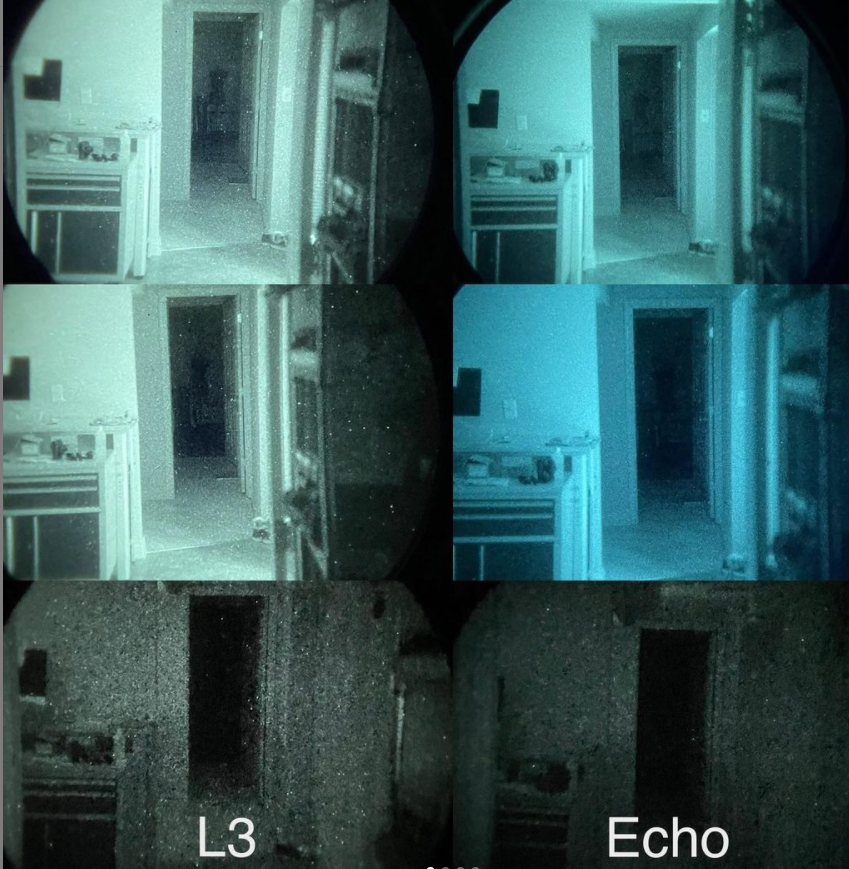
Photonis Echos - what they are and how they perform
Share
Image intensifier technology from Photonis was developed outside of the U.S. and is based on an entirely different concept compared to U.S. made Gen 3 from Elbit Systems and L3. Photonis 4G often gets labeled as "Gen 2+" because it's fundamentally more similar to the multialkali photocathode technology from the US Gen 2 than it is the gallium arsenide (GaAs) tech developed for Gen 3. Thinking of it as "Gen 2+" probably isn't the best way to frame it up, and the term "Hybrid" that is often used in conjunction with Photonis 4G is probably better. It's a "hybrid" because it borrows some elements from different tube tech to create something pretty unique and high-performance in the market.
While Photonis offers their 4G and 4G+ line for MIL/LE applications, the Echo line represents their high-performance civilian offering. The main difference between 'milspec' 4G and Echo, is the milspec 4G has higher gain and resulting image brightness, as well as tighter control on any factory dark spots. In real world testing and comparison against real US "Gen3+" L3 filmless against Echo, the performance of the Echos are comparable and in some situations (eg: high light) even better than L3. In extremely dark areas where both filmless and Echos start to struggle, the higher gain potential in the US tubes become more evident. But we have found that in those situations, both tubes require supplementary illumination in order to assess the scene clearly. You often hear about Photonis 4G Hybrid technology and it's "Echo" line of tubes being a solid alternative to Gen 3 technology for night vision. The most common criticism is that the tech from Photonis does not amplify as much light by comparison and therefore has lower gain.
This is all true. But once again, typically the story stops there and all context is missing, which can be important.

Here we are comparing the highest end L3 unfilmed white phosphor technology to some of the highest performing Echo grade Photonis tubes we had.
What we see here is one data point to show the context of how Photonis Echo compares to the best tubes available in terms of lower gain. What does lower gain really equate to for practical use? The target silhouette in the photos is at a distance of around 45-50 feet in a mixed lighting interior environment common for operations inside a structure. Both the target and the night vision device are in the darkest interior rooms, while the area in between has more ambient light. By making small alterations to the overall ambient conditions in the room of the target, we can see progressively how Photonis compares to L3 unfilmed in a scenario ranging from dark to extreme darkness.

Without a doubt, the unfilmed Gen 3 tube provides more gain and image intensification at all ambient light levels. However, when you add contextual elements, the lines between them performance wise are a bit more blurred.
Target identification is roughly equivalent between the options despite the difference in gain level in all ambient conditions. And by "roughly equivalent" we mean that the use of IR illumination would likely be necessary at the same ambient level for either solution.
Now, a photo is not the same as real, live use in real time. Would the L3 unfilmed provide a slightly quicker reaction time in the MIDDLE ambient condition (near total darkness)? Yes, we believe it would. Whether or not it is a quantifiable advantage is less clear.
This is just one use scenario. Other scenarios may yield different results.
All images are courtesy of @nocturnalitygear
